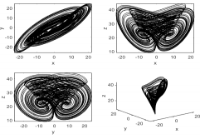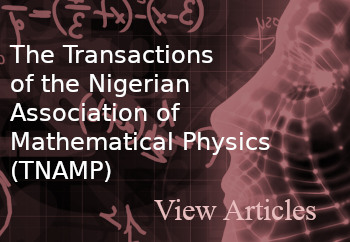Modeling And Prediction Of Fractional-Order Chaotic Lorenz System Using RNN And LSTM Networks
DOI:
https://doi.org/10.60787/jnamp.vol69no1.487Keywords:
Recurrent Neural Networks, Lorenz System, Long Short Term Memory (LSTM), Initial condition, Fractional-order systems, ComplexitiesAbstract
The complexities inherent underlying in the chaotic systems have made long term prediction impossible due to their sensitivity dependence on initial condition. There is need to employ machine learning to detect intricacies as they can capture patterns in complex system and also, extract fractional order behaviour from data. In this study, the comparison between the performance of Recurrent Neural Networks (RNN) and Long Short-Term Memory (LSTM) networks in forecasting fractional-order Lorenz chaotic time series data was investigated. The results show that training and test data for LSTM networks have lower Root Mean Squared Error (RMSE) values than the RNN values, indicating superior generalization to unseen data. By effectively modeling long-term dependencies of the chaotic system, LSTM enhances prediction accuracy and performance compared to traditional RNNs. Accordingly, these findings imply that LSTM networks are more capable of modeling fractional-order dynamics, chaotic systems, thus being more valuable in applications.
Downloads
References
Petráš, I. (2011). Fractional-order nonlinear systems: modeling, analysis and simulation. Springer.
Machado, J. T. and Lopes, A. M. (2019). Fractional-order modeling of a diode. Commun Nonlinear Sci Numer Simul., 70:343–53.
Elwakil, A. S. (2010). Fractional-order circuits and systems: an emerging interdisciplinary research area. IEEE Circ Syst Mag. 10(4):40–50.
Almeida, L. B. (1994). The fractional Fourier transform and time-frequency representations. IEEE Trans Signal Process, 42(11):3084–91.
Akhmet, M. and Fen, M. O. (2016). Replication of chaos in neural networks, economics and physics. Springer.
Kiani-B, A., Fallahi, K., Pariz, N. and Leung H. (2009). A chaotic secure communication scheme using fractional chaotic systems based on an extended fractional Kalman filter. Commun Nonlinear Sci Numer Simul.14(3):863–79.
Muthukumar, P., and Balasubramaniam, P. (2013). Feedback synchronization of the fractional order reverse butterfly-shaped chaotic system and its application to digital cryptography. Nonlinear Dyn., 74:1169–81.
Chua, L. O., Komuro, M., Matsumoto, T. (1986). The double scroll family. IEEE Trans Circ Syst., 33(11):1072–118.
Pham, V. T., Kingni, S. T., Volos, C., Jafari, S., and Kapitaniak, T. A. (2017). Simple three-dimensional fractional-order chaotic system without equilibrium: Dynamics, circuitry implementation, chaos control and synchronization. Int J Electron Commun (AEÜ), 78:220–7.
Zhou, P. and Huang, K. (2014). A new 4-d non-equilibrium fractional-order chaotic system and its circuit implementation. Commun Nonlinear Sci Numer Simulat., 19:2005–11.
Bourouba, B., Ladaci, S., and Chaabi, A. (2018). Reduced-order model approximation of fractional-order systems using differential evolution algorithm. J Control, Autom Electr Syst., 29:32–43.
Baranowski, J., Pauluk, M. and Tutaj, A. (2017). Analog realization of fractional filters: Laguerre approximation approach. Int J Electron Commun (AEÜ), 81:1–11.
Khanra, M., Pal, J. and Biswas, K. (2013). Rational approximation and analog realization of fractional order transfer function with multiple fractional powered terms. Asian J Control, 15:723–35.
Machado, J. T. and Lopes, A. M. (2020). Multidimensional scaling locus of memristor and fractional order elements. J Adv Res, 25:147–157.
Gulian, M., Raissi, M., Perdikaris, P. and Karniadakis, G. (2019). Machine Learning of Space-Fractional Differential Equations. SIAM J. Sci. Comput. [CrossRef]
Wang, B., Liu, J., Alassafi, M.O., Alsaadi, F.E., Jahanshahi, H., Bekiros, S. (2022). Intelligent parameter identification and prediction of variable time fractional derivative and application in a symmetric chaotic financial system. Chaos Solitons Fractals, 154, 111590. [CrossRef]
Woolley, J. W., Agarwal, P. K. and Baker, J. (2010). Modeling and prediction of chaotic systems with artificial neural networks. International Journal for Numerical Methods in Fluids. 63: 989–1004.
Lorenz, E.N. (1963). Deterministic non periodic flow, J. Atmospheric Sci., 20, pp. 130-141.
Lorenz, E.N. (1963). The Essence of Chaos, University of Washington Press, Seattle.
Viswanath, D. and Şahutoğlu. S. (2010). Complex Singularities and the Lorenz Attractor, SIAM Review, Vol. 52, No. 2, pp. 294-314.
Petráš. I. (2022). The fractional-order Lorenz-type systems: A review, Fractional Calculus and Applied Analysis, 25:362–377., https://doi.org/10.1007/s13540-022-00016-4
Hochreiter, S. and Schmidhuber. J. (1997). “Long Short-term Memory”. In: Neural computation 9, pp. 1735–80.
Nicholson. C. (2019). A Beginner’s Guide to LSTMs and Recurrent Neural Networks. https://skymind.ai/wiki/lstm.
Chen, G. (2016). A Gentle Tutorial of Recurrent Neural Network with Error Backpropagation.
Zhang, A., Lipton, Z. C., Li, M. and Smola, A. J. (2023). Dive into Deep Learning. 1st Editiohn, Cambridge University Pess. Uhttp://www.d2l.ai.
Chollet, F. (2018). Deep Learning with Python. Manning Publications.
Zhang, Y., and Zhan, Y. (2018). A Hybrid Approach of LSTM and CNN for Predicting Traffic Flow. IEEE Access, 6, 11180–11188.
Goodfellow, I., Bengio, Y. and Courville, A. (2016). Deep Learning. MIT Press. http://www.deeplearningbook.org.
Sutskever, I., Vinyals, O., and Le, Q. V. (2014). "Sequence to Sequence Learning with Neural Networks." Advances in Neural Information Processing Systems (NIPS), 27.
Lipton, Z.C., Berkowitz, J., Elkan, C. (2015). A Critical Review of Recurrent Neural Networks for Sequence Learning. arXiv preprint arXiv:1506.00019.https://arxiv.org/pdf/1506.00019.pdf
Hochreiter, S. (1998). The Vanishing Gradient Problem During Learning Recurrent Neural Nets and Problem Solutions. International Journal of Uncertainty, Fuzziness and Knowledge-Based Systems 6(02), 107–116.
Van Houdt, G, Mosquer, C., and Nápoles, G. (2020). A Review on the Long Short-Term Memory Model. Artificial Intelligence Review. 53(1). DOI: 10.1007/s10462-020-09838-1.
Thomas, A. (2017). Recurrent neural networks and LSTM tutorial in Python and Tensor Flow. Retrieved from http://adventuresinmachinelearning.com/recurrent-neural-networks-lstm-tutorial-tensorflow/ [34] Olah. C. (2015). Understanding LSTM Networks. Retrieved from http://colah.github.io/posts/2015-08-Understanding-LSTMs/
Zaytar, M. A. and Amrani, C. E. (2016). Sequence to Sequence Weather Forecasting with Long Short-Term Memory Recurrent Neural Networks. International Journal of Computer Applications (0975 - 8887). Volume 143 - No.11.
Monir, S. S. and Zhao, D. (2024). Veclstm: Trajectory Data Processing and Management for Activity Recognition Through LSTM Vectorization And Database Integration. (Computer Science) Machine Learning. DOI: 10.48550/Arxiv.2409.19258.
Yang, C., Taralova, I. and Loiseau, J-J. (2021). Fractional Chaotic system solutions and their impact on chaotic behaviour. The 14th CHAOS 2021 International Conference, Athens (Turn to virtual), Greece. hal-03533065.
Bishop, C. M. (2006). Pattern Recognition and Machine Learning. Springer.
Almaleh A. A. (2024). Novel Deep Learning Approach for Real-Time Critical Assessment in Smart Urban Infrastructure Systems. Electronics (MDPI). 13(16):3286.
Li, H., Rajbahadur, G. K., Lin, D., Bezemer, C-P., Jiang, Z. M. (2024). Keeping Deep Learning Models in Check: A History-Based Approach to Mitigate Overfitting. IEEE Access. 12: 70676 - 70689. DOI:10.1109/ACCESS.2024.3402543.
Sherstinsky, A. (2020). Fundamentals of recurrent neural network (RNN) and long short-term memory (LSTM) network. Phys. D Nonlinear Phenom, 404, 132306.
Madondo, M. and Gibbons, T. (2018). Learning and modeling chaos using LSTM recurrent neural networks, in Proceedings of the Midwest Instruction and Computing Symposium.

Downloads
Published
Issue
Section
License
Copyright (c) 2025 The Journals of the Nigerian Association of Mathematical Physics

This work is licensed under a Creative Commons Attribution-NonCommercial-ShareAlike 4.0 International License.




